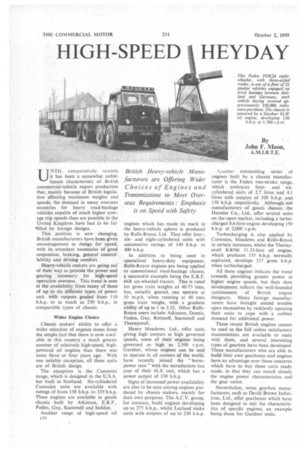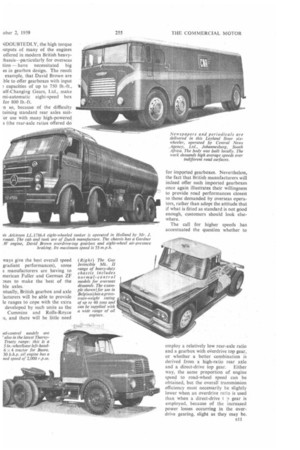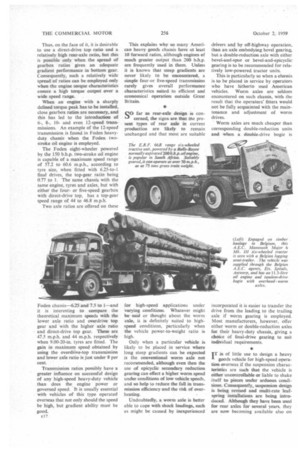HEYDAY
Page 92

Page 93

Page 94

Page 95

If you've noticed an error in this article please click here to report it so we can fix it.
British Heavy-vehicle Manufacturers are Offering Wider Choices of Engines and Transmissions to Meet Overseas Requirements : Emphasis is on Speed with Safety By John F. Moon, A.M.I.R.T.E.
UNT1L comparatively recently it has been a somewhat unfortunate characteristic of British commercial-vehicle export production that, mainly because of British legislation affecting maximum weights and speeds, the demand in many overseas countries for heavy road-haulage vehicles capable of much higher average trip speeds than are possible in the United Kingdom have had to be ful'filled by foreign designs.
This position is now changing. British manufacturers have been given encouragement to design for speed, with its attendant necessities of good suspension, braking, general controllability and driving comfort.
Heavy-vehicle makers are going out of their way to provide the power and gearing necessary for high-speed operation overseas. This trend is seen in the availability from many of them of up to six different types of power unit, with outputs graded from 110 b.h.p. to as much as 250 b.h.p., in comparable types of chassis.
Wider Engine Choice Chassis makers' ability to offer a wider selection of engines stems from the simple fact that there is now available in this country a much greater number of relatively high-speed, highpowered oil engines than there was some three or four years ago. With one notable exception, all these units are of British design.
The exception is the Cummins range, which is designed in the U.S.A. but built in Scotland. Six-cylindered Cummins units are available with ratings of from 158 b.h.p. to 335 b.h.p. These engines are available in goods chassis built by Atkinson, E.R.F., Foden, Guy, Scammell and Seddon.
Another range of high-speed oil engines which has made its mark in the heavy-vehicle sphere is produced by Rolls-Royce, Ltd. They offer four-, sixand eight-cylindered units with automotive ratings of 140 b.h.p. to 400 b.h.p.
In addition to being used in specialized heavy-duty equipment. Rolls-Royce engines are being applied to conventional road-haulage chassis, a successful example being the E.R.F. 66R six-wheeled tractor. This is rated for gross train weights of 40-75 tons, but, suitably geared, can operate at 50 m.p.h. when running at 40 tons gross train weight, with a gradient ability of up to 1 in 3.32. Other RollsRoyce users include Atkinson, Dennis. Foden, Guy, Rotinoff, Scammell and Thornycroft.
Henry Meadows, Ltd., offer units giving high outputs at high governed speeds, some of their engines being governed as high as 2,500 r.p.m. Gardner, whose engines can be said to operate in all corners of the world, have recently joined the "horsepower race" with the introduction last year of their 6LX unit, which has a power output of 150 b.h.p.
Signs of increased power availability are also to be seen among engines produced by chassis makers, mainly for their own purposes. The A.C.V. group, for instance, build engines developing up to 275 b.h.p., whilst Leyland make units with outputs of up to 230 b.h.p. Another outstanding series of engines built by a chassis manufacturer is the Foden two-stroke range, which embraces fourand sixcylindered units of 2.7 litres and 4.1 litres with outputs of 100 b.h.p. and 150 b.h.p. respectively. Although not manufacturers of goods chassis, the Daimler Co., Ltd., offer several units on the open market, including a turbocharged 8.6-litre engine developing 150 b.h.p. at 2,000 r.p.m.
Turbocharging is also applied by Cummins, Meadows and Rolls-Royce in certain instances, whilst the Thornycroft KRN6 11.33-litre oil engine, which produces 155 b.h.p. normally aspirated, develops 217 gross b.h.p. when turbocharged.
All these engines indicate the trend towards providing greater power at higher engine speeds. but their slow development reflects the well-founded cautiousness of British engine designers. Many foreign manufacturers have brought untold trouble upon themselves by recklessly uprating their units to cope with a sudden demand for additional power.
These recent British engines cannot be used to the full unless satisfactory transmissions are available to mate with them, and several interesting types of gearbox have been developed. Those manufacturers who are able to build their own gearboxes and engines have an advantage over those concerns which have to buy these units ready made, in that they can match closely the engine power characteristics and the gear ratios.
Nevertheless, some gearbox manufacturers, such as David Brown Industries, Ltd.. offer gearboxes which have been designed to suit the characteristics of specific engines, an example being those for Gardner units. qDOUBTEDLY, the high torque i.itputs of many of the engines offered in modern British heavythassis—particularly for overseas Lion — have necessitated big es in gearbox design. The result example, that David Brown are .ble to offer gearboxes with input capacities of up to 750 lb.-ft., elf-Changing Gears, Ltd., make mi-automatic eight-speed box for 800 lb.-ft.
n so, because of the difficulty taming standard rear axles suitor use with many high-powered s (the rear-axle ratios offered do
ways give the best overall speed gradient performances), some s manufacturers are having to merican Fuller and German ZF 3xes to make the best of the ble axles.
ntually, British gearbox and axle a.cturers will be able to provide Le ranges to cope with the extra developed by such units as the Cummins and Rolls-Royce :s, and there will be little need
for imported gearboxes. Nevertheless, the fact that British manufacturers will indeed offer such imported gearboxes once again illustrates their willingness to provide road performances closest
to those demanded by overseas operators, rather than adopt the attitude that if what is fitted as standard is not good enough, customers should look elsewhere.
The call for higher speeds has accentuated the question whether to employ a relatively low rear-axle ratio and a gearbox with Mierdrive top gear, or whether a better combination is derived from a high-ratio rear axle and a direct-drive top gear. Either way, the same proportion of engine speed to road-wheel speed can be obtained, but the overall transmission efficiency must necessarily be slightly lower when an overdrive ratio is used than when a direct-drive t p gear is employed, because of the increased power losses occurring in the overdrive gearing, slight as they may be. Thus, on the face of it, it is desirable to use a direct-drive top ratio and a relatively high rear-axle ratio, but this is possible only when the spread of gearbox ratios gives an adequate gradient performance in bottom gear. Consequently, such a relatively wide spread of ratios can be emoloyed only when the engine torque characteristics ensure a high torque output over a wide speed range_ .
When an engine with a sharply defined torque peak has to be installed, close gearbox ratios are necessary, and this has led to the introduction of 6-, 8-, 10and even 12-speed transmissions. An example of the 12-speed transmission is found in Foden heavyduty chassis when the Foden twostroke oil engine is employed.
The Foden eight-wheeler powered by the 150 b.h.p. two-stroke oil engine is capable of a maximum speed range of 57.2 to 60.6 m.p.h., according to Lyre size, when fitted with 6.25-to-1 final drives, the top-gear ratio being 0.77 to 1. The same chassis with the same engine, tyres and axles, but with either the fouror five-speed gearbox with direct-drive top, has a top-gear speed range of 44 to 46.8 mph.
Two axle ratios are offered on these
Foden chassis-6.25 and 75 to 1—and it is interesting to compare the theoretical maximum speeds with the lower axle ratio and overdrive top gear and with the higher axle ratio and direct-drive top gear. These are 47.5 m.p.h. and 44 mph. respectively when 9.00-20-in. tyres are fitted. The gain in maximum speed obtained by using the overdrive-top transmission and lower axle ratio is just under 8 per cent.
Transmission ratios possibly have a greater influence on successful design of any high-speed heavy-duty vehicle than does the engine power or governed speed. It is usually essential with vehicles of this type operated overseas that not only should the speed be high, but gradient ability must be good. This explains why so many American heavy goods chassis have at least 10 forward ratios, although engines of much greater output than 200 b.h.p. are frequently used in them. Unless it is known that steep gradients are never likely to be encountered„ a simple four-or five-speed transmission rarely gives_ overall performance characteristics suited to efficient and economical operation outside Great Britain.
QO far as rear-axle design is con'-' cerned, the signs are that the pre sent types of rear axle in current production are likely to remain unchanged and that most are suitable for high-speed applications under varying conditions. Whatever might be said or thought about the worm axle, it is definitely suited to highspeed conditions, particularly when the vehicle power-to-weight ratio is high.
Only when a particular vehicle i& likely to be placed in service wherelong steep gradients can be expected is the conventional worm axle not recommended, although even then the use of epicyclic secondary reduction gearing can effect a higher worm speed under conditions of low vehicle speeds, and so help to reduce the fail in transmission efficiency and the risk of overheating.
Undoubtedly. a worm axle is better able to cope with shock loadings, such as might be caused. by inexperienced
drivers and by off-highway operation, than an axle embodying bevel gearing but a double-reduction axle with either bevel-and-spur or bevel-and-epicyclic gearing is to be recommended for relatively low-powered tractor units.
This is particularly so when a chassis is to be placed in service by operators who have hitherto used American vehicles. Worm axles are seldom encountered on such chassis, with the result that the operators' fitters would not be fully acquainted with the maintenance and adjustment of worm. drives.
Worm axles are muchcheaper than corresponding double-reduction units and when. a. double-drive bogie is incorporated it is easier to transfer the drive from the leading to the trailing axle if worm gearing is employed. Most manufacturers, however, offer either worm or double-reduction axles for their heavy-duty chassis,, giving a choice of final-drive gearing to suit individual requirements.
IT is of little use to design a heavy goods vehicle for high-speed operation overseas if the suspension characteristics are such that the vehicle is either uncontrollable or liable to shake itself to pieces under arduous conditions. Consequently,. suspension design is being revised and multi-rate leafspring installations are being introduced. Although they have been used for rear axles. for several years, they are now becoming available also on
t axles. Damper design, too, is g extended to cover the conditions .cable to continuous high-speed ation over poor road surfaces, lentually, of course, it is likely many different types of goods sis, both load carriers and prime ars, will be available with air susion. The advance of such designs witness the introduction of indeLent front suspension, which id improve road-holding and ral stability, although the effect such a layout might have on tyre has yet to be assessed.
r suspension is suited to highoperation over indifferent road ices, particularly if the vehicle Id be running unladen. Already merica the system has been shown e virtually foolproof, once it is developed, and far less prone to age and wear than a steel-leaf susion.
nother future suspension system is known to be under considerais an all-hydraulic layout, whilst mbination of the two could result hydro-pneumatic design such as already been applied to one ms make of private ear.
RTUNATELY, British braking design has managed to keep ast of speed increases and, )ugh developments are taking in the field of disc brakes, present-day drum brake with ided facings is suitable for many -speed heavy-duty applications. Export requirements have for several years dictated the general adoption of air-braking systems and these are now offered universally on British heavy-duty chassis, although some makes are available with airhydraulic or vacuum-hydraulic systems. With Vacuum-hydraulic layouts, Hydrovac servos are often employed, these having the advantage of operating with negligible delay.
Brake frictional areas are beginning to reach their maximum values, out art important advance has been the more general adoption of eight-wheeled braking on eight-wheeled chassis, although many manufacturers have offered such brakes on their models for a number of years.
qo far as steering is concerned, one
of the most noticeable trends in recent years has been the widespread adoption of power-assisted systems. This is another trend which has been stimulated by progress in the U.S.A. and such steering layouts are becoming regarded as essential requirements for high-speed vehicles, particularly in hilly areas where drivers quickly become fatigued when negotiating sharp bends if power assistance is not available.
Big improvements have taken place in British cabs. Most of them give drivers far better conditions than have
hitherto been expected, and this is particularly so with regard to noise
and heat insulation, general ventilation, roominess and visibility.
Whilst British manufacturers cannot yet offer complete air-conditioning systems for cabs, they are under development. Several recent cab designs have shown the emphasis that is being placed on easy access to the driving seat, whilst engine accessibility
on many British vehicles is as good as can be expected from a forward-control design without a tilt cab.
When engine accessibility and cab space are paramount considerations, many heavy-vehicle manufacturers offer normal-control layouts. Among them are A.E.C., Guy and Leyland. Such vehicles find a ready market in hot climates. It is in such climates also that engine accessibility becomes allimportant, because of the need for constant attention to air and fuel filters and to the cooling system.
Heavy-duty vehicles of the type dealt with in this article are listed, together with specification details, in the tables on pages 280-308. Most of them can be geared to give maximum speeds of at least 45 m.p.h. and sometimes up to 60 m.p.h. The addresses of these manufacturers appear on page 275.












































































































































































































































